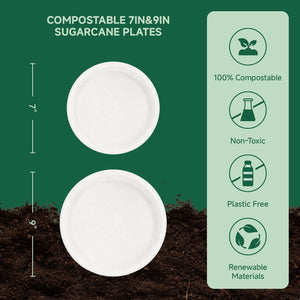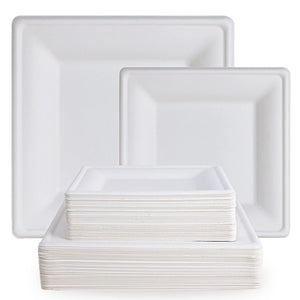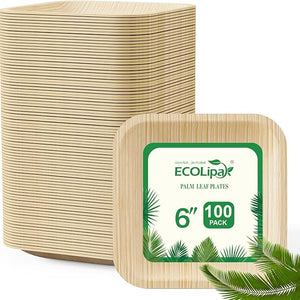You want the best compartment plate for parties, catering, or family meals. Plastic plates feel sturdy but often lack sustainable features. Paper plates bring convenience yet struggle with durability. Fiber plates, like those made from sugarcane, offer a sustainable tableware option that supports making sustainable choices. The global market now favors eco-friendly and compostable plates as environmental awareness grows. Ecolipak leads with sustainable tableware, introducing Compostable Sugarcane 3 Compartment Potluck Plates for your sustainable dining needs. Consider your environmental impact, usability, and budget before making choices.
Key Takeaways
Plastic plates are strong and cheap but harm the environment because they do not break down and create pollution.
Paper plates are easy to use and affordable but often have coatings that reduce their compostability and durability.
Fiber plates made from plants like sugarcane are sturdy, compostable, and eco-friendly, making them the best choice for health and the planet.
Ecolipak’s Compostable Sugarcane 3 Compartment Potluck Plates offer strength, heat resistance, and easy composting for everyday use and events.
Choosing compostable fiber plates helps reduce waste, supports sustainable living, and protects the environment for future generations.
Compartment Plate Types
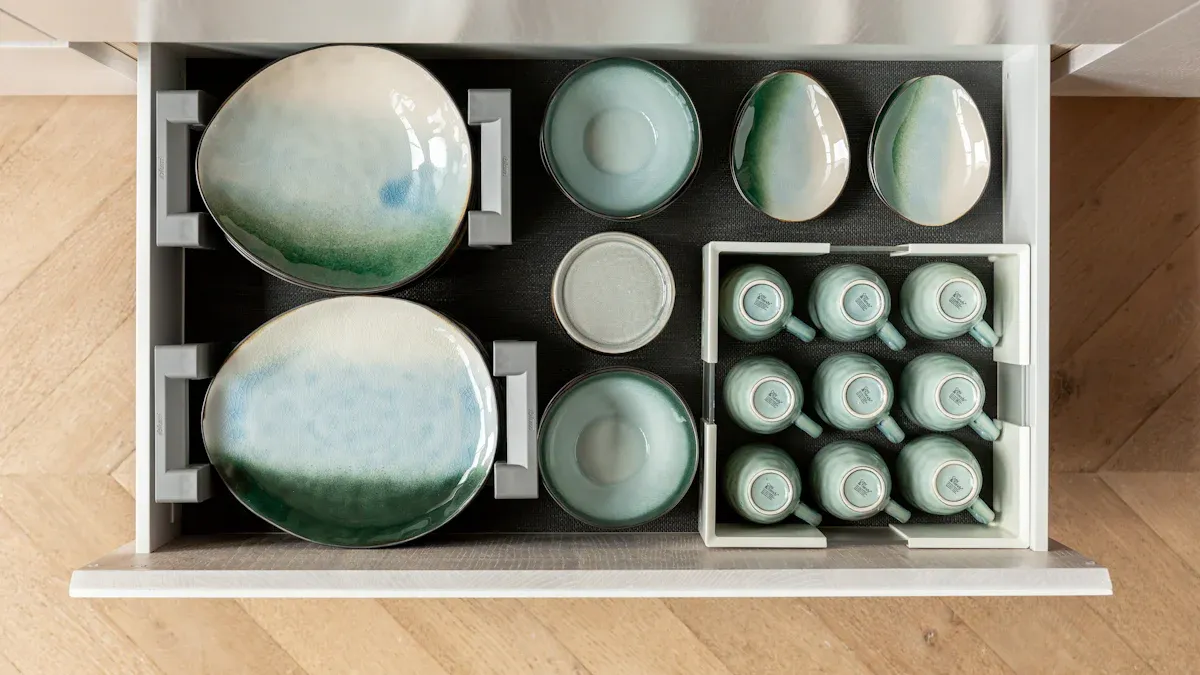
When you choose disposable plates for your next meal or event, you will see three main types: plastic, paper, and fiber. Each compartment plate type has its own materials, strengths, and best uses. Understanding these differences helps you make the right choice for your needs and for the planet.
Plate Type |
Main Materials |
Composition Details |
Environmental Impact |
|---|---|---|---|
Plastic Plates |
Synthetic polymers |
Made from non-biodegradable polymers; some recyclable or reusable versions exist |
Least eco-friendly; non-biodegradable |
Paper Plates |
Wood pulp from trees |
Often coated with bleaching agents and PFAS chemicals to improve durability and moisture resistance |
Compostability affected by chemical coatings |
Fiber Plates |
Sugarcane bagasse, bamboo pulp, wood pulp, other plant fibers |
Made from fibrous plant residues or fast-growing plants; generally lack plastic lining or waterproofing |
Most eco-friendly; biodegradable and compostable |
Plastic
Plastic compartment plates are made from synthetic polymers. These disposable plates feel sturdy and resist breaking, even with heavy or wet foods. You often see them at parties, catering events, and food trucks. Plastic plates are lightweight and can handle hot, oily, or moist foods without leaking. Some plastic plates are reusable or recyclable, but most end up in landfills because they do not break down naturally. This makes them the least eco-friendly option. If you want convenience and strength, plastic plates work well, but they do not support a healthy environment.
Tip: Plastic disposable plates may seem easy, but they can stay in the environment for hundreds of years.
Paper
Paper compartment plates come from wood pulp. Manufacturers often bleach the pulp and add coatings, like PFAS chemicals, to make the plates stronger and more water-resistant. These disposable plates are popular for picnics, parties, and large gatherings because they are lightweight and easy to use. You can quickly clean up after meals by tossing them away. However, the chemical coatings can make paper plates less compostable and less friendly to the environment. If you want a quick and simple solution, paper plates are a common choice, but they may not always be the greenest.
Paper disposable plates are easy to find and use.
Chemical coatings help prevent leaks but can harm compostability.
Production uses a lot of resources and energy.
Fiber
Fiber compartment plates use plant-based materials like sugarcane bagasse, bamboo pulp, and wood pulp. These plates are called plant fiber plates. They come from renewable resources and break down naturally in compost. Fiber disposable plates do not need plastic linings, so they are safer for the environment. You can use them for hot, cold, wet, or oily foods. Many eco-conscious families and businesses now choose fiber plates for events, catering, and daily meals.
Ecolipak’s Compostable Sugarcane 3 Compartment Potluck Plates stand out in this category. These plates use sugarcane bagasse, a byproduct of sugar production. They are sturdy, microwave-safe, and freezer-safe. The three compartments help you keep foods separate and control portions. You can use these disposable plates for potlucks, family dinners, or picnics. When you finish your meal, you can compost the plate, knowing it will return to the earth without harm.
Note: Choosing fiber disposable plates, like Ecolipak’s sugarcane plates, helps protect the environment and supports a healthier future for your family.
Durability and Usability
Sturdiness
When you serve a hearty meal, you want plates that can handle the weight. Plastic plates feel strong at first, but they can warp or bend with heavy or saucy foods, especially when hot. Paper plates often become soggy and weak, especially if they do not have a special coating. Fiber plates, like those made from sugarcane bagasse, stand out for their heavy-duty design. You can pile on meats, salads, or saucy dishes, and these plates will not bend or get soggy. Many families and caterers choose fiber plates for their reliability at big events.
Feature |
Plastic Plates |
Paper Plates |
Fiber (Bagasse) Plates |
|---|---|---|---|
Heat Resistance |
Warps under high heat |
Poor without coating |
Up to 220°C, keeps shape |
Oil Resistance |
High |
Poor without coating |
Excellent, no coating needed |
Leak Resistance |
1–2 hours |
Less than 1 hour |
2–3 hours, no warping |
Structural Support |
Can deform |
Becomes soggy |
Heavy-duty, no bending |
Tip: Ecolipak’s Compostable Sugarcane 3 Compartment Potluck Plates give you the confidence to serve any meal, from barbecue to pasta, without worrying about leaks or mess.
Heat and Moisture Resistance
You may want to reheat leftovers or store food in the freezer. Not all disposable dinnerware can handle this. Many plastic plates melt or warp in the microwave. Paper plates are not microwave-safe and can catch fire or fall apart. Fiber plates, especially those made from sugarcane, are microwave-safe and freezer-safe. You can safely reheat food or store it cold without the plate losing its shape.
Material |
Microwave Safety |
Freezer Safety |
Heat Resistance |
|---|---|---|---|
Sugarcane Bagasse |
Yes |
Yes, down to -20°C to -40°C |
Up to ~120°C, no deformation |
Plastic |
Varies, some may warp |
Varies, some become brittle |
Some melt or deform |
Paper |
No |
Short-term only |
Soaks/warps with hot liquids |
Ecolipak’s plates also resist oil and cuts, so you can serve fried foods or use metal cutlery without worry.
Portion Control
Compartment plates help you keep foods separate and manage portions. Most plastic, paper, and fiber plates come in sizes from 9 to 10 inches, perfect for main courses and balanced meals. The three compartments in Ecolipak’s plates make meal planning easy. You can serve a protein, a side, and a salad without mixing flavors or sauces.
Plate Size (inches) |
Typical Use |
Meal Planning Impact |
|---|---|---|
8.75-9 |
Lunch plates, 5-compartment trays |
Portion control, food separation |
9-10 |
Dinner plates for main courses |
Ideal for full meals, balanced nutrition |
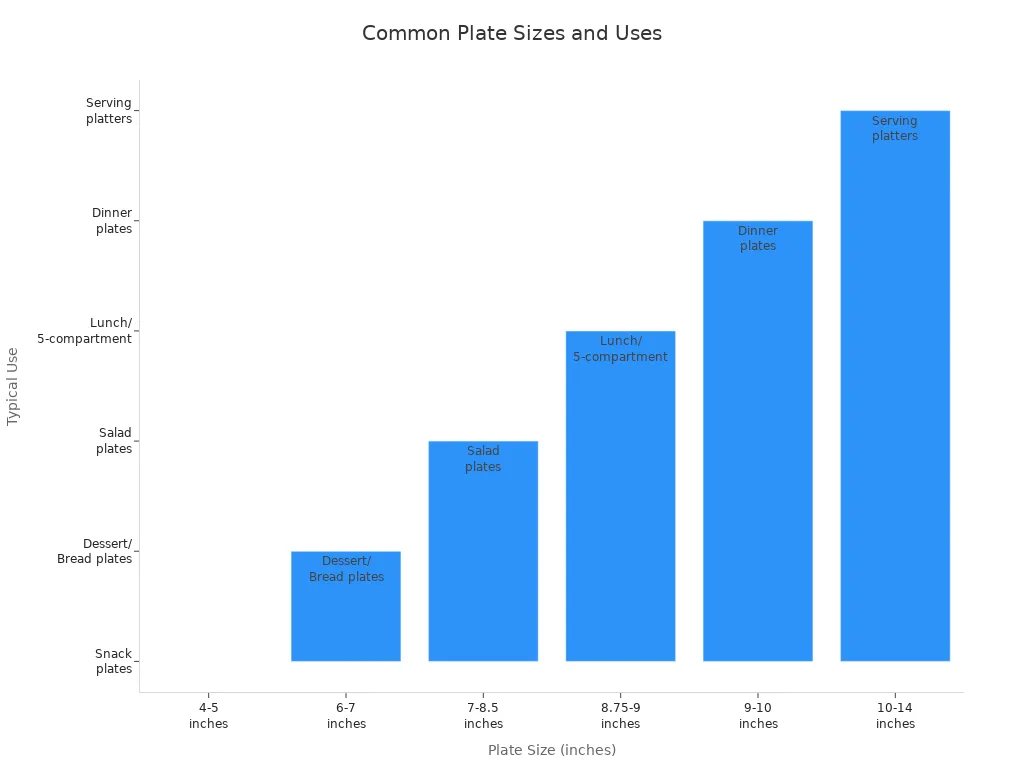
Note: Choosing the right compartment plate helps you serve healthy meals and reduces food waste. Ecolipak’s design supports families who care about nutrition and the environment.
Sustainable Choices
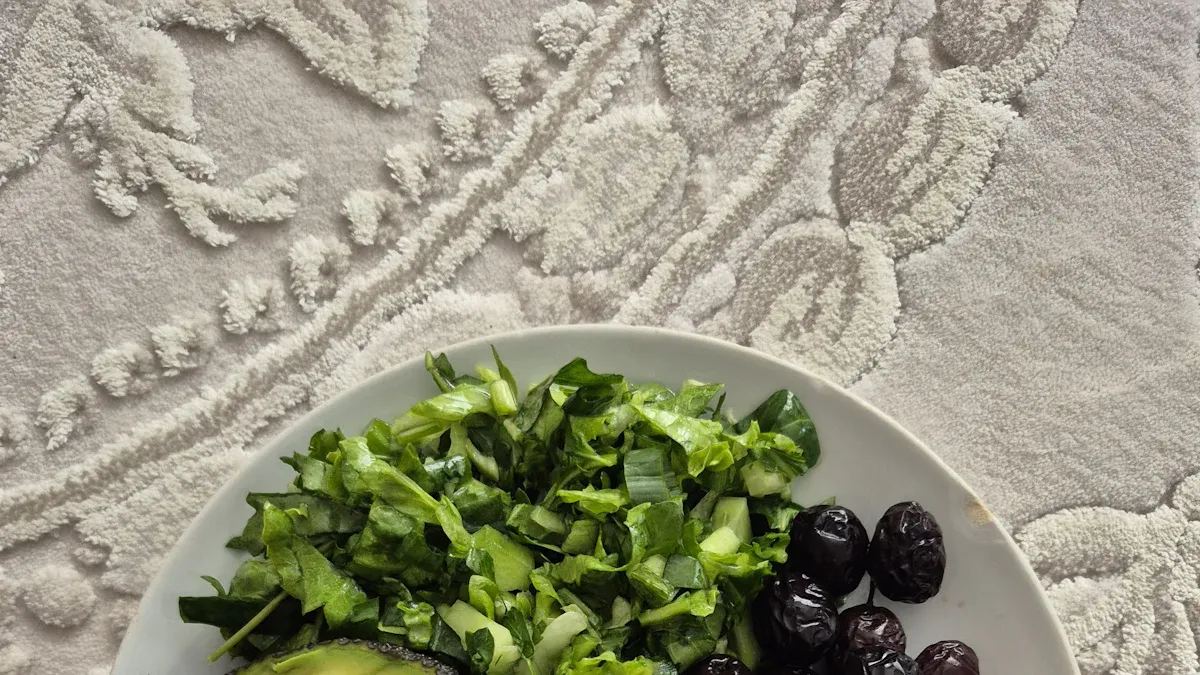
Environmental Impact
You make a big difference when you choose sustainable tableware for your meals and events. Every plate you use has an environmental impact from the moment it is made until it is thrown away. You can help protect the environment by learning how each type of plate affects the world around you.
Plastic plates create the most environmental problems. Factories use fossil fuels to make plastic, which leads to pollution and greenhouse gas emissions. When you throw away plastic plates, they do not decompose. They stay in landfills for hundreds of years and can break into tiny pieces called microplastics. These microplastics pollute soil and water, harming animals and people.
Paper plates seem like a better alternative, but they also have environmental costs. Making paper plates uses a lot of water and energy. Many paper plates have chemical coatings that make them less biodegradable and compostable. These chemicals can leak into the environment and cause pollution. If you recycle paper plates, you reduce waste, but coated plates often cannot be recycled.
Fiber plates, such as those made from sugarcane bagasse or bamboo, offer a sustainable and eco-friendly alternative. These plates come from renewable plants and break down naturally. When you use fiber plates, you lower pollution and help the environment. Fiber plates are biodegradable and compostable, so they decompose quickly and add nutrients to the soil.
🌱 Choosing biodegradable and compostable plates helps you reduce pollution and protect the environment for future generations.
Here is a table that shows the environmental impact of different plate materials:
Material Type |
Environmental Impact Highlights |
Key Lifecycle Considerations |
|---|---|---|
Plastic (Polypropylene) |
Significant environmental impacts, especially in disposal phase; microplastic pollution concerns |
Requires incineration or landfill disposal; recycling reduces impact; fossil-based, non-compostable |
Bamboo Fiber |
Better environmental coordination; lower impacts on human health and ecosystems |
Fast-growing resource; biodegradable; adds nutrients to soil; lower energy consumption in processing |
Biodegradable (PLA, starch composites) |
Sometimes higher total environmental impact than polypropylene due to land use and agriculture inputs |
Compostable but land use and eutrophication impacts; disposal method affects outcomes; trade-offs in water and land use |
You can see that fiber plates, especially those made from bamboo or sugarcane, have the lowest environmental impact. They support a sustainable lifestyle and help you make eco-friendly choices every day.
Compostable Plates
Compostable plates give you a simple way to care for the environment. When you use compostable plates, you help reduce waste and pollution. These plates break down in compost piles and return to the earth as healthy soil. You do not need to worry about them filling up landfills or harming wildlife.
You find many compostable plates made from plant fibers like sugarcane bagasse. These plates are biodegradable and compostable, so they decompose quickly. You can use them for hot, cold, wet, or oily foods. After your meal, you place the plate in a compost bin, and it turns into soil in a few months.
Ecolipak’s Compostable Sugarcane 3 Compartment Potluck Plates stand out as a sustainable tableware choice. These plates use sugarcane bagasse, a renewable resource. They are sturdy, eco-friendly, and designed for easy composting. You support sustainability when you choose Ecolipak’s compostable plates for your family or event.
💡 Compostable plates help you create less waste and support a cleaner environment. You make a positive impact every time you choose biodegradable and compostable tableware.
Ecolipak believes in sustainability and eco-friendly alternatives. The brand has sold over 59 million sustainable products in 2024, protecting 125,000 square meters of green space. Ecolipak’s mission is to help families and businesses choose compostable plates and other biodegradable products. You join a growing community of people who care about the environment and want to make a difference.
You can help protect the environment and reduce pollution by choosing compostable plates. You support a sustainable future for your family and your community. Compostable plates make it easy to live an eco-friendly lifestyle and keep the planet healthy.
Cost Comparison
Price Range
When you shop for disposable plates, you want to know how much you will spend. Plastic disposable plates usually cost the least per piece, especially when you buy in bulk. Paper disposable plates are also budget-friendly, but prices can rise if you choose thicker or coated options. Fiber disposable plates, like those made from sugarcane, often cost a bit more than plastic or paper. This is because they use renewable materials and eco-friendly processes. However, you can find affordable compostable plates that fit your budget and help the planet.
Here is a quick look at the price range for each type:
Plate Type |
Typical Price per Plate |
Eco-Friendliness |
|---|---|---|
Plastic |
$0.05 – $0.12 |
Low |
Paper |
$0.06 – $0.15 |
Moderate |
Fiber (Sugarcane) |
$0.12 – $0.25 |
High |
Note: Ecolipak’s Compostable Sugarcane 3 Compartment Potluck Plates cost about $0.19 per plate when you buy a box. You get a sturdy, eco-friendly option at a fair price.
Value
You want more than just a low price. You want value for your money. Plastic disposable plates can be reused a few times, but most people throw them away after one use. Paper disposable plates are almost always single-use. Fiber disposable plates, while also single-use, give you extra value through their strength and eco-friendliness.
Consider these points when thinking about long-term value:
Fiber disposable plates break down in compost, so you help the environment every time you use them.
Plastic disposable plates last longer if reused, but they add to landfill waste and pollution.
Paper disposable plates may seem cheap, but coatings can make them less green.
Ecolipak’s fiber disposable plates offer a balance of strength, sustainability, and cost.
You make a smart choice when you pick Ecolipak. You get reliable disposable plates that support your values and protect your family’s health. You also help reduce waste and keep the earth clean for future generations.
Disposal and Compostable Alternatives
Compostable
You want a clean end of life for your plates. Compostable plates offer a sustainable alternative that supports your environmental values. When you choose compostable plates made from fiber, such as Ecolipak’s sugarcane plates, you help reduce waste and support healthy soil. These plates meet strict composting standards, breaking down quickly in commercial composting facilities. Ecolipak’s sugarcane plates are certified to disintegrate within twelve weeks, so you can trust they will decompose and return nutrients to the earth. You can place these biodegradable and compostable plates in your green bin if your city accepts food-soiled items. This process keeps your environment clean and helps protect future generations.
🌱 Compostable plates give you an eco-friendly alternative for parties, family meals, and events. You make a positive impact every time you choose compostable plates.
Recycling
You may wonder if you can recycle your plates. Most plastic plates cannot be recycled in regular municipal programs, especially if they have food residue. Clean plastic containers, like bottles and jugs, are accepted, but plates rarely meet these requirements. Paper plates with food stains or coatings should not go in recycling bins. Fiber plates, similar to food-soiled paper, are best composted or placed in the trash if composting is not available. Recycling works best for clean, dry materials. If you want to recycle, always check local guidelines and keep food waste out of the recycling stream.
Material Type |
Recycling Rate (%) |
|---|---|
Paper and Paperboard |
|
Plastics |
9 |
Landfill
Sometimes you have no choice but to send plates to the landfill. Plastic plates persist for years, showing little to no decomposition after twelve months. Paper and fiber plates, made from cellulose, decompose in about eight months. While this is faster than plastic, landfill conditions slow the process. Compostable plates offer a better solution, but if you must use the landfill, fiber plates remain a more sustainable alternative than plastic. You help the environment by choosing biodegradable options whenever possible.
Note: Choosing compostable plates like Ecolipak’s sugarcane plates gives you peace of mind. You know your choice supports eco-friendly alternatives and a cleaner planet.
Real-Life Scenarios
Events
You often need compartment plates for events like birthday parties, barbecues, or corporate gatherings. Each event has its own needs. For casual gatherings, such as outdoor BBQs or sweet sixteen parties, people usually pick paper plates. These plates are light, colorful, and easy to clean up. You can carry them anywhere, which makes them perfect for picnics or on-the-go meals. Many people choose paper plates because they save time and reduce the need for washing dishes.
For formal events, like weddings or business dinners, you want plates that look elegant and feel sturdy. Larger, single-color plates made from fiber or high-quality plastic work well. If you serve hot, wet, or greasy foods, you need plates that will not leak or bend. Fiber plates, especially those made from sugarcane, offer both strength and a clean look. They also support your goal of hosting a green event.
Here is a quick guide to help you choose:
Event Type |
Plate Type/Material |
Why Choose It? |
|---|---|---|
Formal events |
Sturdy fiber or plastic plates |
Elegant, strong, suits formal settings |
Casual gatherings |
Paper plates, lighter fiber plates |
Easy cleanup, colorful, portable |
Multi-course events |
Compartment fiber plates |
Keeps food separate, handles sauces and sides |
Eco-friendly events |
Compostable fiber plates (bagasse) |
Sustainable, compostable, supports green goals |
Tip: Compostable fiber plates, like Ecolipak’s sugarcane plates, help you impress guests and protect the environment at the same time.
Everyday Use
At home, you want plates that make meals simple and healthy. Many families use compartment plates to help with portion control and to keep foods separate. Plates with clear sections, like the 3-compartment design, encourage balanced meals and make it easier for kids to eat more fruits and vegetables. You may see these plates in lunchboxes, school cafeterias, or family dinners.
Factors that influence your choice include how easy the plate is to use, how well it matches your family’s eating habits, and whether it supports healthy eating. Plates like Ecolipak’s Compostable Sugarcane 3 Compartment Potluck Plates fit well into daily routines. They are sturdy, safe for hot or cold foods, and compostable after use. You can use them for quick lunches, meal prep, or even picnics. Many people find that switching to compostable fiber plates reduces waste and supports a healthier lifestyle.
Corporate cafeterias and restaurants have switched to compostable bagasse plates, cutting waste and getting positive feedback from employees and customers.
Families enjoy the convenience of disposable dinnerware that is both strong and eco-friendly.
At events and in daily life, Ecolipak’s plates have helped people reduce landfill waste and support sustainability.
Note: When you choose compostable plates for your home or event, you show care for your family’s health and the planet’s future.
Quick Comparison
Pros and Cons
When you choose disposable plates, you want to know what works best for your needs. Each type of compartment plate has its own strengths and weaknesses. Here is a simple breakdown to help you decide:
-
Plastic Disposable Plates
Pros: Strong, lightweight, and resist leaks. Good for hot, oily, or wet foods. Often the cheapest option.
Cons: Not biodegradable. Most end up in landfills. Can contain chemicals. Not the best for the environment.
-
Paper Disposable Plates
Pros: Affordable and easy to find. Lightweight and convenient for quick meals or picnics.
Cons: Weak with heavy or wet foods. Many have coatings that slow decomposition. Some contribute to deforestation.
-
Fiber Disposable Plates (Bagasse, Bamboo)
Pros: Made from plants or recycled materials. Biodegradable and compostable within 60–90 days. Durable, heat and oil resistant. Support a healthy planet.
Cons: Higher cost than plastic or paper. Some have a rougher texture.
🌱 If you want a disposable plate that balances strength, sustainability, and health, fiber plates like those made from sugarcane are a top choice.
Summary Table
You can use this table to compare the main features of each disposable plate type:
Plate Type |
Degradability |
Heat/Oil Resistance |
Sturdiness |
Environmental Impact |
Average Price per Plate |
|---|---|---|---|---|---|
Plastic |
Non-biodegradable |
High |
Moderate |
High |
|
Paper |
Varies (slow if coated) |
Low–Moderate |
Low |
Moderate |
$0.04–$0.12 |
Fiber (Bagasse, Bamboo) |
Compostable in 60–90 days |
High |
High |
Low |
$0.05–$0.25 |
You see that fiber disposable plates offer the best mix of eco-friendliness and performance. Plastic disposable plates work for short-term needs but harm the environment. Paper disposable plates are easy to use but may not hold up with heavy meals. When you care about your family’s health and the planet, fiber disposable dinnerware stands out as the smart, responsible choice.
You have many options when choosing compartment plates. Plastic plates work for quick, sturdy needs, while paper plates offer convenience for casual gatherings. If you want to make eco-conscious choices, fiber plates stand out. Compostable sugarcane plates reduce landfill waste, avoid harmful chemicals, and support a circular economy. Ecolipak’s Compostable Sugarcane 3 Compartment Potluck Plates give eco-conscious consumers a reliable, earth-friendly solution. Choose what fits your needs, but remember that your decision shapes a healthier planet for everyone.
FAQ
What makes fiber plates better for the environment?
Fiber plates come from renewable plants like sugarcane. You can compost them after use. They break down quickly and help keep soil healthy. Choosing fiber plates supports environmental protection and reduces waste.
Can I use disposable dinnerware in the microwave?
You can use fiber plates, such as Ecolipak’s sugarcane plates, in the microwave. They stay sturdy and safe. Plastic and paper plates may melt or warp. Always check the label before heating food.
Are compostable plates safe for hot and oily foods?
Compostable plates made from sugarcane bagasse resist heat and oil. You can serve hot meals and fried foods without leaks or bending. These plates help you enjoy every meal while caring for the planet.
How do I dispose of compostable plates at home?
You can place compostable plates in your home compost bin if local rules allow. They break down into soil in a few months. If composting is not available, choose a green waste bin or landfill as a last option.
Why should families choose eco-friendly disposable dinnerware?
Eco-friendly disposable dinnerware protects your family’s health and the environment. You reduce plastic waste and support green living. These plates offer strength and safety for daily meals and special events.





